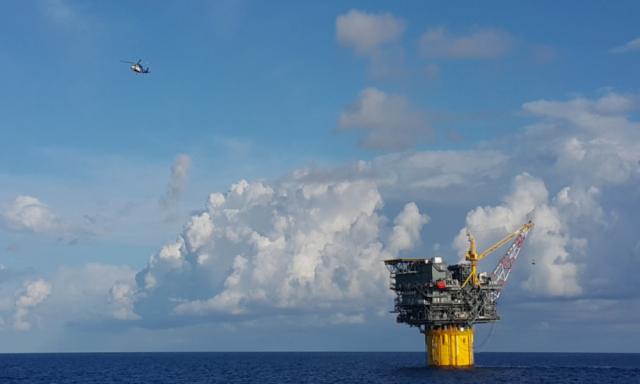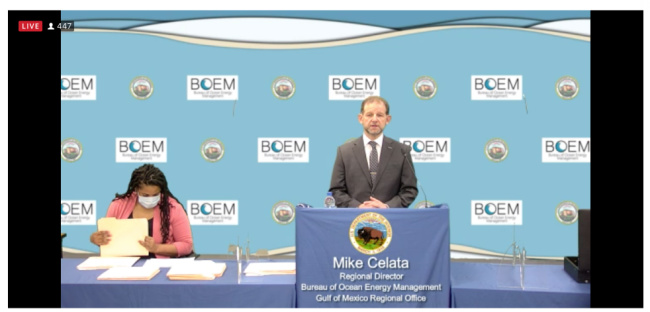
A helicopter departs a spar during crew change day at an oilfield in the Gulf of Mexico. (Source: Harris Hamdan/Shutterstock.com)
Oil and gas companies with eyes on longer-term demand still have an appetite for resources of the U.S. Gulf of Mexico (GoM), evidenced by nearly $121 million in high bids placed on blocks offered during the last federal offshore lease sale of 2020.
The U.S. Bureau of Ocean Energy Management’s (BOEM) Nov. 18 sale—which offered blocks for oil and gas development offshore Texas, Louisiana, Mississippi, Alabama and Florida— attracted 23 companies that placed 105 bids, preliminary statistics showed.
The bids were placed on only 93 of the more than 14,860 blocks offered.
That’s an improvement from the lease sale in March when 22 companies placed bids on 71 blocks, bringing in more than $93 million in high bids.
Results of the Nov. 18 lease surpassed the goals of Mike Celata, regional director for BOEM’s GoM region.
“I think the Gulf and I’ve said this often, especially in the deep water, is a place where companies can explore. We have the infrastructure. We can make discoveries, tie into that infrastructure, bringing greater returns to those companies,” Celata said on a media call following the sale. “So, I’m pleased. …The Gulf has a long future. We still have a huge amount of resources in deep water.”

Lease Sale 256 took place as oil and gas companies continue to endure oil price volatility, weak returns and a fuel demand threatening pandemic. Though offshore projects have longer development cycles, the pace of progress can be affected by near-term cash available.
“Every dollar spent today is just the start of additional investment in America,” Erik Milito, president of the National Ocean Industries Association, said in a statement. “Companies will spend millions of dollars exploring, evaluating, and, hopefully, producing from many of today’s lease blocks.”
The sale also comes as the industry faces regulatory uncertainty. The sale is the last before President-elect Joe Biden, who vowed not to issue new permits on federal lands and waters, steps into office. Such moves, if carried out, could deal a blow to the nation’s energy security and the financial coffers of not just oil companies but also federal, state and local governments.
Kate MacGregor, deputy secretary of the Interior Department, pointed out that lease sales are being carried out under a five-year plan that was released by the Obama administration.
“That lease program, while it has the lowest number of lease sales in the history of a five-year program at just 10, still had Gulf of Mexico leasing,” MacGregor said. “I think there is an acknowledgment of the fact that these revenues are incredibly important to the federal Treasury, and I think there’s also acknowledgment of the fact that these jobs are extremely important to the Gulf of Mexico, to the people living in Gulf States and to our entire nation who uses this oil and natural gas.”
RELATED: Panel Mulls 'What If' Scenarios for Offshore Oil Under Biden Administration
Companies are still excited about the GoM, which is estimated to contain about 48 billion barrels of undiscovered technically recoverable oil and 141 trillion cubic feet of undiscovered technically recoverable gas.
“You still see the same companies interested,” Celata said. Major oil players, including BP Plc, Shell and Equinor, were among the companies willing to shell out big bucks.
Equinor Gulf of Mexico LLC and Repsol E&P USA Inc. teamed up to place the highest bid of the sale—nearly $12 million—on Walker Ridge Block 365. The bid was about six times the nearly $2 million bid placed by Chevron USA Inc.
Equinor and Repsol, working with co-venturer Progress Resources USA Ltd., hit net oil pay at their Monument prospect located on nearby Walker Ridge Block 316. Celata said the companies may have a prospect to the east.
The top five companies based on sum of high bids submitted were:
- Shell Offshore Inc., $27,877,809;
- Equinor Gulf of Mexico LLC, $22,158,274;
- BP Exploration & Production Inc., $17,130,319;
- Chevron USA Inc, $17,098,072 and
- EnVen Energy Ventures LLC, $7,699,000.
Competition was high for a couple of blocks in Mississippi Canyon.
Chevron was the apparent high bidder at more than $2.2 million for Mississippi Canyon Block 382, narrowly outbidding Hess Corp. and Anadarko US Offshore LLC which placed bids of about $2.1 million and $1.5 million, respectively, for the same block.
Four companies vied for Mississippi Canyon Block 426, where a $1.5 million bid from BP came in higher than the rest.
“There’s probably some shallow Miocene, but there is some potential in the Mesozoic there that we’re looking at,” Celata said, adding there are some deep expulsion-rollover systems that companies could be prospecting. The frontier-like nature of the area could also be why the blocks garnered million-dollar bids, instead of $10 million ones, he said.
In all, companies are being more selective in what they bid on, especially since COVID-19, according to Walter Cruickshank, acting director of BOEM.
“They’re not bidding on as many tracks as they used to. But they are bidding on those where they see value,” he said.
Mfon Usoro, senior research analyst for Wood Mackenzie, pointed out that bidding activity Nov. 18 trended below the average high bid amount of previous regionwide lease sales though it was 30% higher than the March sale.
“The increase in bid amount was driven by the majors and private companies increasing their spend by 39% and 14%, respectively,” Usoro said in a statement. “Most notable was EnVen Energy driving bidding in its peer group with US$7.7 million to beef up its Infrastructure-led exploration drilling inventory.”
Blocks with water depths greater than 800 m continue to be the most attractive to GoM players.
BOEM is in the process of updating its resource assessment in the GoM, particularly in deep water, and making sure blocks are receiving fair market value.
Long-term demand is part of the picture considering it typically takes seven to 10 years for some developments to reach first oil, though existing infrastructure and tiebacks can shave off years and cut costs.
“The past year has been tough, but the noted increase in winning bids and number of bids on tracts demonstrates the continued resilience of the U.S. Gulf of Mexico,” said Milito. “Long-term projections still show rising energy demand, including for oil and natural gas, and with its world-class infrastructure, safety and environmental performance and positive environmental justice attributes, the U.S. Gulf of Mexico should remain the region of choice for energy production.”
BOEM has proposed holding its first GoM lease sale of 2021 in March. Lease Sale 257 would be the eighth offshore sale of the current Outer Continental Shelf Oil and Gas Leasing Program and the first under the Biden administration.
“With the Biden administration set to inaugurate next year and possibly ban future lease sales, a massive land grab might have ensued. But companies are constrained by tight budgets due to the prevailing low oil price,” Usoro said. “Additionally, companies in the region have existing drilling inventory to sustain them in the near term. The best blocks with the highest potential reserves are likely already leased.”
Companies winning leases are required to pay a 12.5% royalty rate for blocks in water depths of less than 200 m and a royalty rate of 18.75% for all other leases.
Recommended Reading
Where, When and How to Refrac—Weighing All the Options
2024-07-12 - Experts weigh in on strategic considerations when deciding how to rejuvenate production from a tired well.
Shell Offshore Takes FID on Waterflood Project in GoM
2024-08-14 - Shell Offshore’s waterflood secondary recovery process involves injecting water into the reservoir formation to extract oil.
E&P Highlights: July 22, 2024
2024-07-22 - Here's a roundup of the latest E&P headlines, with LLOG acquiring 41 blocks in the Gulf of Mexico and Saipem securing $500 million in contracts from Saudi Aramco.
Tech Trends, URTeC Edition: Unconventional Solutions for Unconventional Resources
2024-07-16 - In this month’s Tech Trends, which takes place at the 2024 Unconventional Resources Technology Conference, new technologies are on display that ensure both efficient and sustainable operations.
Goodbye Manual Control: Vital Energy’s Automation Program Boosts Production
2024-07-12 - Production, ESP efficiency soared when the company automated decisions with AI at the edge.
Comments
Add new comment
This conversation is moderated according to Hart Energy community rules. Please read the rules before joining the discussion. If you’re experiencing any technical problems, please contact our customer care team.






